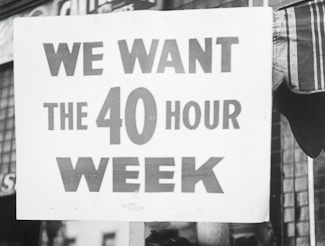|
The month of May is an opportunity to recognize and appreciate labor history in the United States. The efforts and sacrifices of the American workers and the labor movement have provided innumerous benefits that all Americans enjoy today, or may take for granted. The month of May has been a historical month for labor efforts throughout history, several examples are listed below:
May 1 – Recognized as International Workers’ Day, started in 1889 in an effort to have a unified demonstration in an effort to achieve the eight-hour work day.
May 4, 1886 – The Haymarket Riot took place in Chicago, Illinois, where workers gathered following a large demonstration on May 1 for the eight-hour work day. During the demonstration the Chicago Police with little reason attempted to disperse the crowd. During the police activity an unknown individual threw a homemade bomb. By the end, seven police officers were killed and four workers. Afterwards, for a public display, eight labor advocates, some of which were not even at Haymarket, were convicted of conspiracy and seven were sentenced to death. Four of the sentences were carried out by hanging and the three others were pardoned, but one other committed suicide prior to being pardoned. One of the executed, August Spies famously stated prior to his hanging, “The day will come when our silence will be more powerful than the voice you are throttling today.”
May 11, 1894 – The Pullman Strike began in Chicago, Illinois. The Pullman Palace Car company employees went on strike in response to a reduction in wages without a reduction in the cost of living in the company town. The American Railway Union, under Eugene Debbs, got involved and halted the movement of trains with Pullman cars. The strike was broken by a Federal injunction and 12,000 federal troops. By the end, 250,000 workers in 27 states were involved. There was 30 workers killed and 57 others injured. Following the strike, President Grover Cleveland created and designated the Labor Day holiday that we observe on the first Monday of September.
May 12, 1902 – Over 140,000 anthracite coal miners went on strike in Eastern Pennsylvania seeking higher wages, better working conditions, and recognition of their union (United Mine Workers of America). The strike lasted for months and the resulting coal shortage with winter approaching led President Teddy Roosevelt to intervene and create a commission to investigate the cause of the dispute.
May 17, 1971 – Brotherhood of Railroad Signalmen, 13,000 members strong, went on a national strike after an inability to reach agreement, seeking raises for the technical work of the craft. At the time signalmen were making $3.78 to $3.81 an hour, a wage lower than that of common laborers in numerous occupations.
May 20, 1926 – The Railway Labor Act is passed by Congress, providing the framework for representation, collective bargaining, and labor dispute resolution for railroad workers.
May 21, 1936 – Railroad Labor Organization signed the national Washington Agreement which is still in effect today and provides protective benefits and protections for rail workers affected by a line sale by an individual Carrier.
This recognition was exemplified in 1995, when President Bill Clinton recognized May of that year as Labor History Month and stated:
“Among the most insistent themes in the history of American democracy has been the determination of our workers to find dignity in their work and meaning in their citizenship. The labor movement has long given voice to these aspirations. American trade unionists have fought for and achieved benefits for all of us by strengthening citizens' roles in the workplace and by expanding their participation in the political lives of their communities.
Gone is the time when the average American worker made about ten dollars for a 60-hour week, and more than 2 million children worked similarly long hours for even less pay. The national labor movement has helped ensure safe working conditions, regular hours, decent living wages, and paid holidays and vacations. And in 1993 we moved a step further, affording hard-working Americans the right to emergency family leave.
Workers have been leaders in the efforts to establish the 8-hour day, the 40-hour week, security in unemployment and old age, protection for the sick and injured and for children, equal employment opportunity, and health and safety standards. And the labor movement has strived to make public education available for every child. American workers have helped to make this progress possible, and our country is immeasurably stronger because of it.”
As union members, we should take pride in the accomplishments of our predecessors and continue on the path towards prosperity for ourselves and American workers as a whole. Union proud, Union strong.
|








 Paused2023 Q2 Signalman's Journal2023 Q1 Signalman's Journal2022 Q4 Signalman's Journal2022 Q3 Signalman's Journal2022 Q2 Signalman's Journal
Paused2023 Q2 Signalman's Journal2023 Q1 Signalman's Journal2022 Q4 Signalman's Journal2022 Q3 Signalman's Journal2022 Q2 Signalman's Journal








